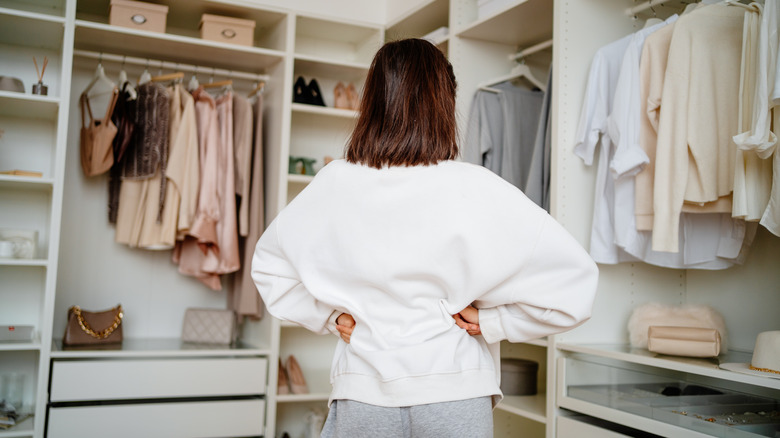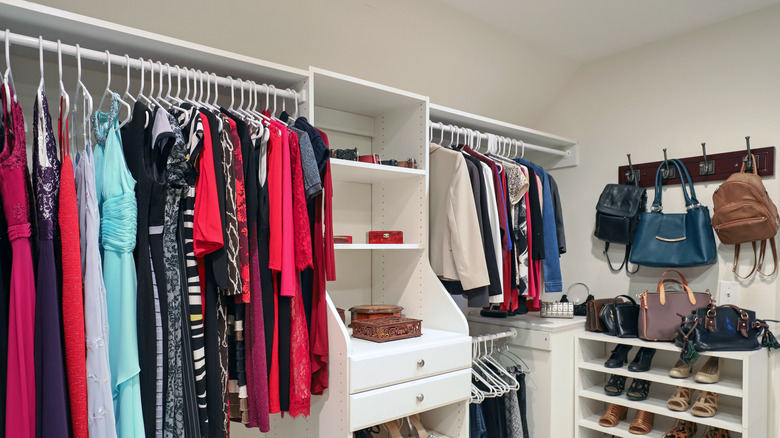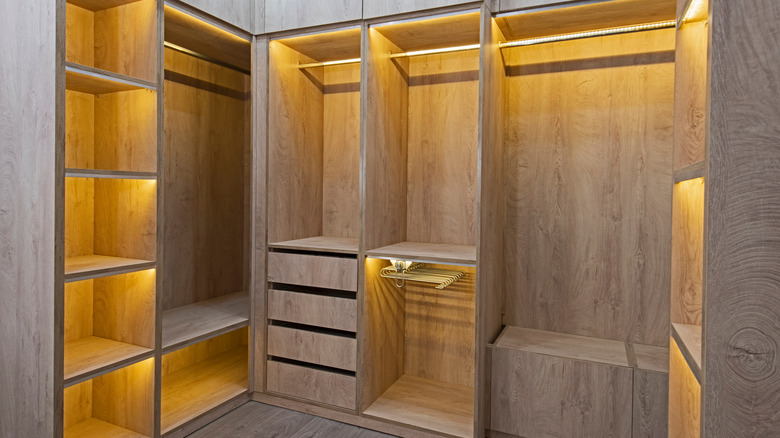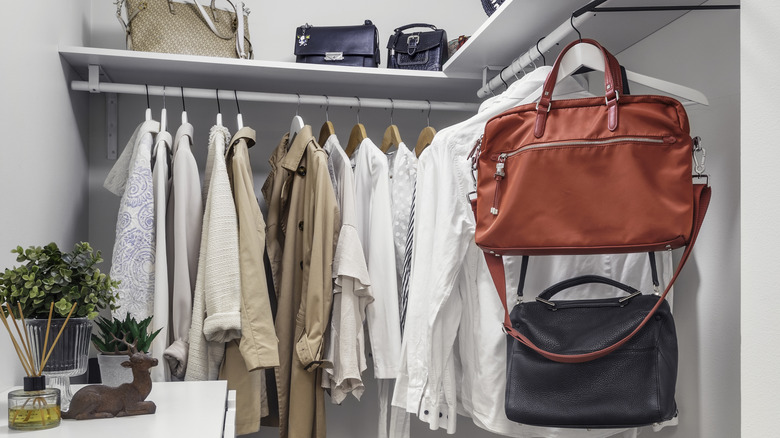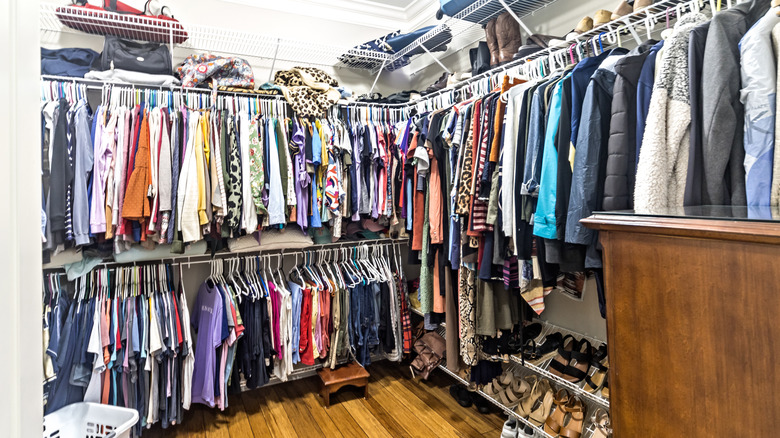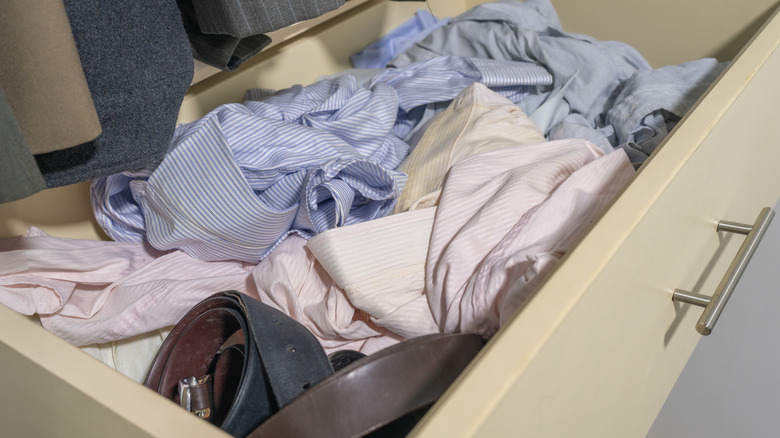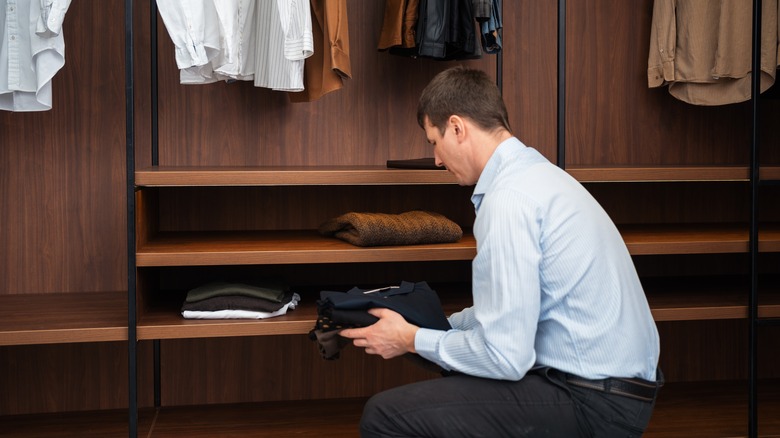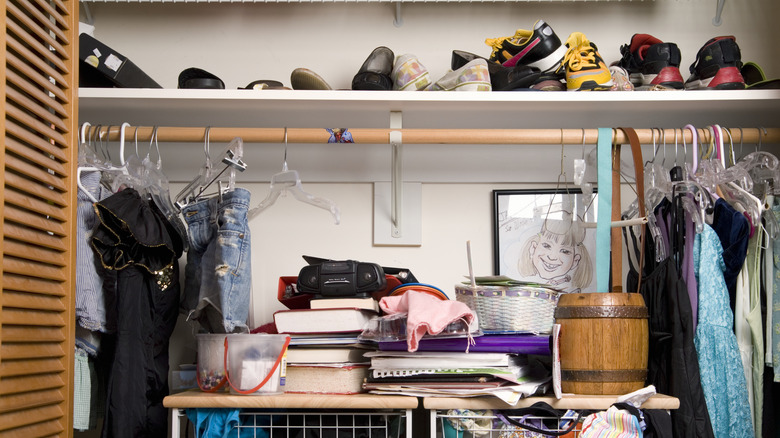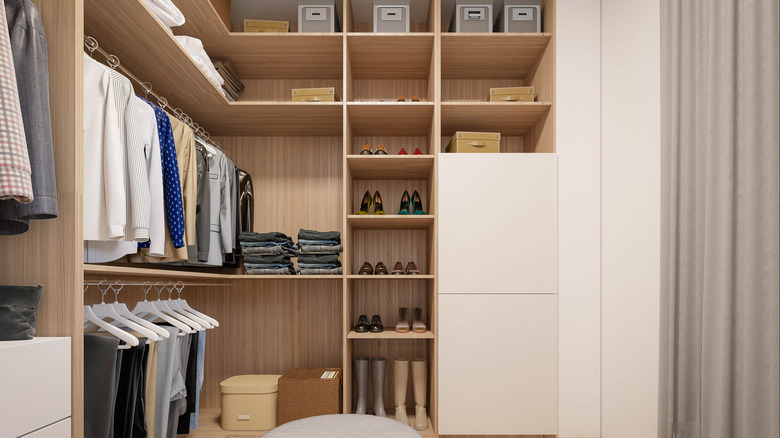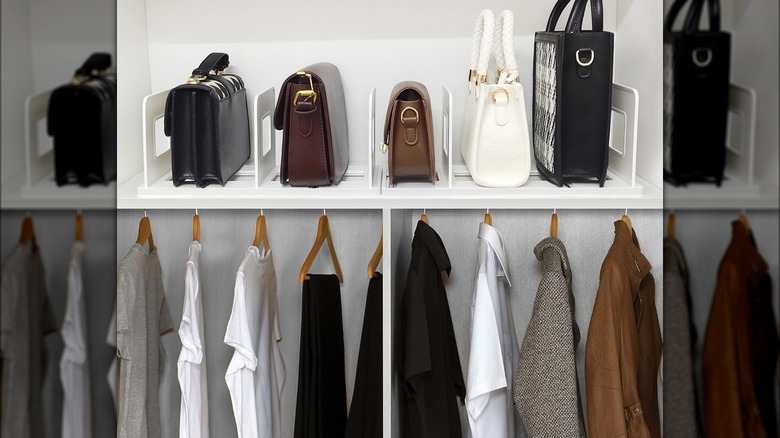Walk-In Closet Storage Mistakes That Can Lead To Cluttered Chaos
We may receive a commission on purchases made from links.
In theory, a spacious walk-in closet should solve all of your clutter woes. After all, with so much space, it should be easy to keep everything organized, right? Wrong. In fact, sometimes the opposite can be true. A large closet can look even more cluttered than a small one, simply because there is more space to be taken over by a lack of organization.
There are several walk-in closet storage mistakes that can stand in your way of achieving an organized closet. Whether you have a walk-in that needs to be saved from creeping clutter or are moving into a new home and want to start off on the right foot to prevent it from turning into a disaster, you've come to the right place. We have assembled some of the most common storage mistakes people make with their walk-in closets. We'll share some information about why each of these is indeed a mistake, along with some tips to help you avoid making the same errors in your space.
Leaving too much dead space
Dead space is the enemy when it comes to keeping your walk-in closet organized and clutter-free. "Dead space" refers to any parts of the closet that are either empty or not being utilized as effectively as they could be. For example, if you have a large section of wall without any rods, shelves, or drawers, that would be considered dead space. Belongings are more likely to pile up in these areas, which can make it hard to find what you need while also making the space look like a disaster. Similarly, a portion of the space above the top shelf can also be considered dead space if it is too tall. If you have 2 feet of space above the shelf, you aren't going to be able to effectively use it. Stacking items that tall is likely going to cause something to tip over, or it will just make the space look messy.
So, how do you avoid dead space? Well, to start, if you're designing a new closet, make sure the top shelf can be effectively used for storing hat-boxes or off-season clothes that don't always need to be accessible. You can store these in boxes, and stack two or three on top of each other. Secondly, you can install a second shelf above the first one, bringing you closer to the ceiling and creating a whole new level of storage space.
Other types of dead space can also be better utilized with a few modifications that won't involve getting an entirely new closet system. Consider installing a few shelves, bringing in some rolling plastic drawers, or adding some hooks to hang jewelry, bags, belts, or other accessories.
Installing a system that is not adjustable
If you're planning to have a new system installed in your walk-in closet, don't make the mistake of choosing one that is not adjustable. While there might be some appeal to having the more finished look of permanent shelving and rods without any of the holes to allow you to adjust the spacing, you're just setting yourself up for future woes. The problem with non-adjustable closet systems is that you can't change them in the future. If your storage and organization needs (or even preferences) look different than they do now, you won't be able to alter your closet to meet them. You'll end up with more clutter simply because the shelving layout doesn't match your storage requirements.
Instead, speak with a closet design company about installing adjustable shelving. This way, you can adjust the space between the shelves based on the items you're storing. Right now, you may want to use the space for bulky blankets, but in a few years, you might want to use it to hold much smaller items. With adjustable shelving, you can easily make this change that would be practically impossible with fixed shelves.
Not considering double closet rods
Consider the design of your walk-in closet right now. Do you only have single rods for hanging all of your clothing items? If so, then you're missing out on some valuable storage space — and probably making your closet look more cluttered than it needs to. Single rods are great for hanging long dresses or full-length coats. But, other than those, how many of your clothing items really require all the space between the high closet rod and the floor? Probably not many.
Enter double closet rods. As the name implies, this means you'll have two closet rods spanning the width of the same area of the closet. These rods will double your closet storage space, making it easier to organize your clothes and keep them from looking cramped on a single rod. As you're hanging items up, consider putting your pants (folded over a pants hanger) on the top rod and your shirts on the bottom rod. Folded pants should take up a bit less space vertically, which will allow you to utilize the shelf between the two rods for shoes, bags, or other items, further maximizing your closet space. Just remember that you'll still want some single-rod hanging space to accommodate those longer dresses, coats, and other items.
Installing shelves that aren't deep enough
If you're planning to have a new closet system installed — or are just looking to add a few new shelves yourself to eliminate dead space — remember, deeper is better. Some closet organizers, particularly cheaper wire models, may only have 12-inch shelves. Similarly, some closet designers may recommend 12-inch shelves, as they'll be cheaper. Whatever you do, push to make sure you get shelves that are at least 14 inches deep. Since you have a walk-in, you have the space for it.
While 2 inches may not sound like a lot, it can make a big difference when it comes to how useful and effective the shelf will be for storing your items. Folded blankets, towels, jeans, or sweaters, are likely to need more than 12 inches of space to fit fully on a shelf. Similarly, if you or your partner have large feet, your shoes may barely fit on a 12-inch shelf. You can also fold seasonal items in the back, storing them out of sight but nearby when they're not needed. Then, when the weather changes, rotate them forward.
Not installing specialty drawers for accessories
One of the biggest benefits of a walk-in closet is all the extra space it offers. When you have that much space, you should make the most of it to help keep all of your belongings neatly organized. Drawers can be an asset in any walk-in closet. Just don't make the mistake of installing only standard ones. With large open spaces, all of your accessories, such as jewelry, scarves, or belts are going to end up in a huge heap in the middle of the drawer. It will be too difficult to keep all of these smaller items organized and easy to find if the drawer isn't appropriately designed.
While you could opt for some drawer organizers, if you're going through the design process still, you should consider specialty drawers and trays. Take a look at IKEA's PAX interior organizers. As an example, you could try the Komplement Pull-Out Tray with Insert (which costs $135 at IKEA) to keep your jewelry organized and right at your fingertips.
Not installing motion sensor lights inside the cabinets and drawers
Adequate lighting is a must-have when you're looking to upgrade a walk-in closet. Because the space is much larger than a standard closet, it is going to be difficult for you to find what you want and really compare the various clothing, jewelry, and other accessory options available to you. While some people may install an additional overhead light in a closet, it won't clearly illuminate all of the different drawers and cabinets you have in the space — especially if they're deeper in the wardrobe or in a corner.
Consider adding some motion sensor lights in these areas. This way, they can illuminate the drawer or shelf when you're looking to find something, but won't waste electricity when not in need. For drawers, you can find lights that automatically turn on when the motion of opening the drawer triggers the operation. Try these motion-sensing lights by Kuled ($16.99 for three) on Amazon.
Storing your shoes on shelves rather than rotating units
It is common to find shoe cubbies or shelves — either flat or angled — in a walk-in closet. And, while these aren't inherently bad, you may be missing out if you opt for one of these methods of shoe storage. There are a few potential problems with using shelves for your shoes. First of all, they take up a lot of space. If you have an extensive collection, you might find that you don't have much shelf space left to hold sweaters, linens, purses, and other accessories. Second, when your shoes are on shelves, they could end up toppling over, especially if you accidentally bump them when reaching for something on a nearby shelf or rod.
Fortunately, you can avoid all of these potential issues by choosing to use a rotating shoe rack instead. Rotating racks can hold a lot of shoes without taking up too much of your precious closet space. Their circular design — similar to that of a rotating spice rack — can be placed in the corner of the closet. It will provide several slots, organized around the cylindrical rack, to hold pairs of shoes. You can easily find the pair you're looking for by turning the rack. You could even organize shoes by season or person by grouping them in a given row or column. Proudly display your favorites by leaving the rack turned with them facing out to increase the aesthetic appeal of your closet.
Not installing some closet door cabinets
If you're still in the planning — or even dreaming — stage for your walk-in closet design, one thing you don't want to skip is installing some closed door cabinets. When you're thinking about walk-in closet design essentials for storage and organization, cabinets that close are at the top of the list. While open shelves are nice if you want to display some of your favorite items, they will also openly display your messier side. With a few closed doors, you can keep some of these sections out of sight.
Plus, with a closed door, you can also keep more private items hidden. You could even install a hidden safe in your walk-in closet behind one of these cabinets, if desired. Cabinet doors could also be further integrated into the overall design of your closet. For example, you could consider having mirrored doors installed in some sections. This way, if you don't have the extra wall space to dedicate to a mirror — or don't want to give up any extra space — you'll still be able to check how you look after getting dressed.
Putting your bags on an open shelf without an organizer
People with handbag collections dream of the day they can display them on a large shelf wall, allowing them to see all of their choice. While most walk-in closets can accomodate that setup, you don't want to simply put them all on a shelf without any thought to organization. First, piling up bags will just make the shelf look cluttered and messy. Even more than that, they're much more likely to get bumped, fall to the ground, or knock something else off, creating even more of a mess. Instead, look for a handbag organizer.
These products will keep your bags neat and organized. Instead of digging and searching for the one you need, you'll be able to easily see your various options and quickly grab the one you want for each occasion. You can buy a purse organizer online. Alternatively, if you're looking to save a bit of money and are ready for a simple DIY project, consider making your own purse organizer using magazine holders. Smaller purses will slide seamlessly inside the slot, keeping them tidy and ready for use when you need them.
